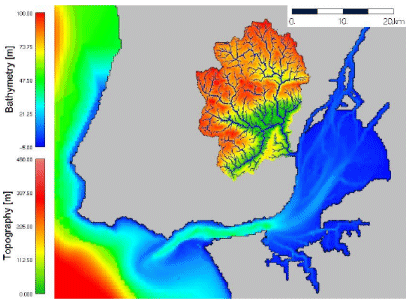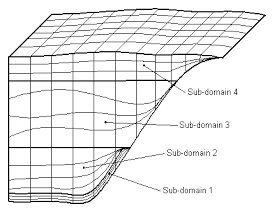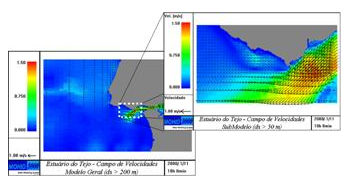What is MOHID?
The Evolution of MOHID
The development of the MOHID model started back in 1985, passing since this time through continuously updates and improvements due to its use during different projects of scientific research and engineering projects. Initially the MOHID water modelling system was a bi-dimensional hydrodynamic model, called MOHID 2D (Neves, 1985a). This model was used to study estuaries and coastal areas using a classical finite difference approach.
In the following years, a bi-dimensional eulerian and lagrangian transport model were included in this model. The first three-dimensional version was introduced by Santos (1995b), which used a vertical double Sigma coordinate. This version was called MOHID 3D.
The limitations of the double Sigma coordinate revealed the necessity to develop a model which could use a generic vertical coordinate, permitting the user to choose the type of vertical coordinate, depending on the study area. Due to this necessity the concept of finite volumes was introduced with the version Mesh 3D by Martins (1999c). In the Mesh 3D model were included a three dimensional eulerian transport model, a three dimensional lagrangian transport model (Leitão, 1996d) and the zero-dimensional water quality model (Miranda, 1997e). Since the introduction of the finite volumes approach, this discretisation remains in the model MOHID.
With the growing model complexity, it was necessary to introduce a new way in the organization of the information of the MOHID model. In 1998 the whole code was submitted to a complete rearrangement, using the new feature of programming languages and also the capacities of the computer to reprogram the whole MOHID model. The main goal of this rearrangement was to turn the model more robust, reliable and protect its structure against involuntary programming errors, so it would be more easily “grow able”.
To achieve this goal, objected oriented programming in FORTRAN was introduced to the MOHID model, although FORTRAN is not an object oriented language. This migration began in 1998, implementing object oriented features like those described in Decyk et al. (1997f) with significant changes in code organization. This migration resulted in an object oriented model for surface water bodies which integrates scales and processes.
The philosophy of this new MOHID model, further on simple designated MOHID, permits to use the model in any dimension (one-dimensional, two-dimensional or three-dimensional). The whole model is programmed in ANSI FORTRAN 95, using the objected oriented philosophy. The subdivision of the program into modules, like the information flux between these modules was object of a study by the MOHID authors.
The object oriented modular design of this model was the base to build the present MOHID Water Modelling System, which is a set of several numerical tools. Actually MOHID Water Modelling System is composed by over 40 modules which complete over 240 000 code lines.

MOHID is a three-dimensional water modelling system, developed by MARETEC (Marine and Environmental Technology Research Center) at Instituto Superior Técnico (IST) which belongs to the Universidade de Lisboa in Portugal.
The MOHID modelling system allows the adoption of an integrated modelling philosophy, not only of processes (physical and biogeochemical), but also of different scales (allowing the use of nested models) and systems (estuaries and watersheds), due to the adoption of an object oriented programming philosophy.
The integration of MOHID different tools, (MOHID Water, MOHID Land and MOHID Soil) can be used to study the water cycle in an integrated approach. Since these tools are based on the same framework, the coupling of them is easily achieved.
MOHID has been applied to different study cases, as coastal and estuarine areas, as well as oceanic processes and reservoirs, and it has showed its ability to simulate complex features of the flows.
Main Properties
- Possibility to run different applications simultaneously;
- Easily adaptable to new application areas;
- Spatial discretisation using the finite volume approach technique (the spatial coordinates are independent, and any geometry can be chosen for every dimension), allowing more flexibility in the subdivision of the vertical and horizontal domain, and in implementation of innovative vertical coordinates, adaptable to each particular case;

- Permits to use the model in any dimension (1D, 2D and 3D);
- Can use different time steps for different modules;
- Can use nested models, only limited by the available computational power;
- Possibility of parallel running of different models in separated processors, communicating between themselves using the MPI protocol (Message Passing Interface), thus allowing a very meaningful gain in calculating time.

References
aNeves R J. A Bidimensional Model for Residual Circulation in Coastal Zones. Application to the Sado Estuary. Annalles Geophysicae. 1985; 3 & 4: 465-472.
bSantos A J (1995). Modelo hidrodinâmico tridimensional de circulação oceânica e estuarina. PhD thesis. Technical University of Lisbon, Portugal.
cMartins F A (1999). Modelação matemática tridimensional de escoamentos costeiros e estuarinos usando uma abordagem de coordenada vertical genérica. PhD thesis. Technical University of Lisbon, Portugal. Available for download here. (In Portuguese)
dLeitão P C (1996). Modelo de dispersão lagrangeano tridimensional. MSc dissertation thesis. Technical University of Lisbon, Portugal. Available for download here. (In Portuguese)
eMiranda R (1997). Nitrogen biogeochemical cycle modeling in the North Atlantic Ocean. MSc dissertation thesis. Technical University of Lisbon, Portugal. Available for download here. (In Portuguese)
fDecyk V K, Norton C D, Szymanski B K. Expressing Object-Oriented Concepts in Fortran90. ACM SIGPLAN Fortran Forum . (1997); 16(1): 13-18. DOI: 10.1145/263877.263880.


